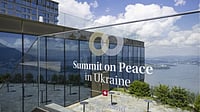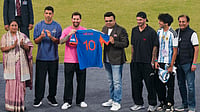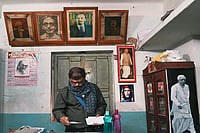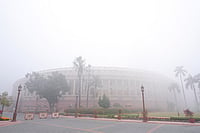Sixty-year-old Mohun Sundar tunes his sarod before the first session as dinner gets under way at the Ghar-e-Kabab restaurant on Kathmandu's Durbar Marg. Blind since birth, he wears a pair of black wraparound sunglasses in the dimly-lit establishment. But even then, he senses that something isn't quite right.
"Not many here tonight again," he mutters to his son, the tabla player, who calls himself, simply, Sundar. The young man grunts and warms up for another evening's work with little or no audience. In fact, only about three tables are occupied in the restaurant, said to have the best Mughlai cuisine in Kathmandu.
What's missing are the Indian diners. Not too many years ago, this was the in place for Indian tourists, but not in these days of royal massacres, Hrithik Roshan riots and Indian Airlines hijackings. Waiter Shiv Thapa gazes wistfully out of the door, hoping to see a few more customers. But at Ghar-e-Kabab, this is as good as it gets.
Ever since five Islamic militants climbed on board the IC-814 at the Kathmandu airport on Christmas eve, 1999, tourist inflow from India has been on the decline. Official figures say it's down by more than 40 per cent. Hoteliers and people in the travel business paint a much worse picture. They say the government is counting businessmen and Nepalese with Indian passports just to make the dismal figures look better.
"It can't get any worse," says Narendra Bajracharya, the inconsolable president of the Hotel Association of Nepal (han). "We've had the most amazing run of bad luck, bad publicity and bad handling of all our crises. And who's paying for it? We in the hotel industry, that's who."
Finding an Indian tourist in the streets of Kathmandu used to be easy. Extended Punjabi families from Delhi, Bengalis and Mumbaikars would gather on New Road, Kathmandu's main shopping street. The women would harangue the shopkeepers and bargain with the electronics merchants—picking up a video camera or dvd to smuggle back home in the hand luggage.
New Road is an Indian-free zone these days. Plenty of people of Indian appearance are in the shops but everyone I spoke to was a Nepali citizen, business people from Kathmandu or the Terai, taking advantage of the quiet times in the bazaar. "We don't see Indians anymore in Birgunj or Janakpur," says Sanjeev, a 26-year-old salesman who tours the border towns of India and Nepal for a multinational soap company. "Even the (Hindu) pilgrims have been wary of crossing over. They keep hearing stories about Indians getting beaten up or gheraoed. I've never experienced it but I'm told it has happened".
Nepal hasn't taken the decline in Indian arrivals lying down. The Nepal Tourism Board was created a few years ago to fight in the country's corner—particularly in India—but it's had a tough job on hand since birth. Pradeep Raj Pandey, the board's chief executive officer, doesn't believe in pulling his punches. "We've had bad media coverage in India," he says. "Reporters come here when something bad like the royal massacre happens and they give the impression that it's always like this. That's why we're now meeting journalists on trips to India, hoping they'll come see us when things are calm, like now, and report that we're quite welcoming and it's worth the trip".
Pandey's pet project this year has been the Nepal Festival of Life, a programme of holiday packages and discounts exclusively for Indian nationals. "It was launched on May 1, and seemed to be working.But after the tragedy at the Royal Palace, we lost more than 80 per cent of our Indian guests in June. Understandably, it was not a time for a holiday in Nepal," admits the tourism board ceo.
Judging by the empty hotels and streets in Kathmandu, it isn't now either. The four-star Grand Hotel used to be able to count on 80 rooms full of Indians during the monsoon season, making up for all the Europeans who shy away from the rain. Now, says manager Sanket Lamichanne, they have just a single tourist family in residence. "Almost all our monsoon bookings were cancelled after the massacre," he says.
There's another reason Indians aren't coming to Nepal, according to hoteliers like Daman Pradhan of the upmarket Shangri La Resort—tough new restrictions on travel documents. As a security measure following the IC-814 hijacking, Nepal and India now require either passports or voter identity cards to travel between the two countries. Once a ration card or a dog-eared affidavit of identity from a gazetted official had been enough. "So they've made them get a passport," says an indignant Pradhan, gesturing at a guest register which shows not a single Indian guest, "and the traveller says 'well, I might as well go to Thailand or Mauritius or the Maldives'. This is adding insult to injury".
Pradhan tells the story of a group of 37 Indians from Delhi who tried to board a flight at the Indira Gandhi Airport last year but were turned away at the Indian Airlines counter. Why? Well, the 34 adults had passports but the three children didn't. "There are enough stupid examples like this," says Pradhan. The silliest thing is that a terrorist can still cross the land border where he doesn't need a passport. Only air travellers do.
In a final desperate search for a visiting Indian who wasn't selling soap or servicing a client, I went to one of Kathmandu's glitzy casinos. Gambling came to the Hindu kingdom three decades ago with one purpose in mind: if Indian gamblers want to lose money, they should do it here, in a friendly neighbouring land. But even at the tables of Casino Royale, the top gaming palace in town, the chips weren't looking up.
Moving around the gambling floor, watching croupiers and customers alike, is Sri Lankan Tania Arnolda, advisor at the Royale. "What we're seeing is a decline in the casual gamblers," she explains, "the family on a package deal that duck in for a night's roulette in between shopping and visiting religious sites. We're down to the hard core of players as we call them, repeat customers who like to gamble, and like our casino."
At the blackjack table, I meet G.T. Ramani, a Delhi travel agent who's been throwing good money after bad at the Casino Royale for 15 years now. He spends the off season in Kathmandu because, quite simply, he loves to gamble. And he's scornful of those tourists staying away. "Sure there's anti-India feeling here, why wouldn't there be? We're always playing big brother, pushing them around. But Nepalis are really too wonderful to let it get serious or violent. In fact, since the massacre people have been doubly friendly to me, anxious to prove that they can survive this, I guess. I'm bringing groups here in October and you'll see things start to get better then." However, Ramani adds a proviso. "If," he says, "they straighten out the Maoist problem."
And that's the biggest if of all. The rabidly anti-Indian Maoist militants are about to sit down for talks with a senior team nominated by new prime minister Sher Bahadur Deuba. Few people have high expectations of an early breakthrough, and more violence is likely if talks break down.
"Look at it this way," says Narendra Bajracharya, "Indian tourists are worried about the same thing Nepalis are; safety, security, law and order. If Nepalis can't have those guaranteed, how can we tell the Indians to come? The decline in tourism is part and parcel of our other problems and we can't solve one without the others."
There's Room For Panic
It's crisis time for Nepal's hospitality industry—what with wary Indian tourists blotting it off their holiday radar

There's Room For Panic
There's Room For Panic
Published At:
MOST POPULAR
WATCH
MORE FROM THE AUTHOR
×




















